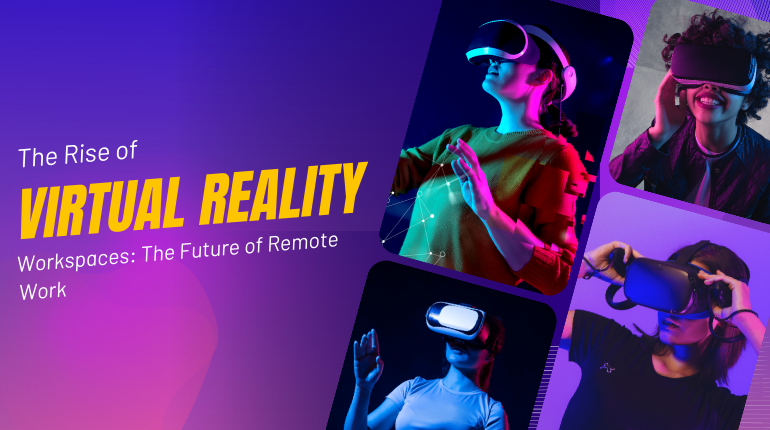In recent years, the notion of the workplace has experienced a profound shift. The global pandemic acted as a spark, speeding up the adoption of remote work and prompting companies to reconsider their operational frameworks.
In the center of this era of digital transformation, one trend is emerging as a potential game-changer for professional environments: the rise of virtual reality (VR) workspaces.
An Innovative Approach to Cooperation
The appeal of VR workspaces stems from their capacity to offer immersive, interactive environments that overcome geographical issues. Unlike conventional video conferencing tools, which can feel distant and impersonal, VR technology provides a sense of presence and engagement akin to face-to-face interactions. Within a virtual space, employees can collaborate in virtual meeting rooms, ask questions using digital whiteboards, and explore 3D project visuals.
Virtual Reality Workspaces: What Are They?
Virtual reality workspaces are digital environments accessed through VR headsets and technologies. These virtual platforms allow teams to interact, meet, and collaborate regardless of their physical locations. They can replicate a traditional office setting or create entirely new spaces. VR workspaces provide a more immersive and dynamic experience compared to conventional video conferencing.
The Development of Virtual Reality Workspaces
Several factors are driving the emergence of virtual reality workspaces:
- Developments in VR Technology: Companies are now more likely to use virtual workspaces, thanks to better VR gear and software. Sharper displays, snappier controls, and improved visuals enable more lifelike and captivating experiences.
- Increasing Trends in Remote Work: As working from home becomes more popular, there is a need for improved virtual collaboration technologies. Virtual reality workspaces provide an answer by simulating the cooperative elements of an office setting.
- Better Teamwork: In an additional realistic way, augmented reality workspaces allow for real-time interactions and collaborative tasks, including those in the field of project management, virtual meetings, or discussions about ideas.
Benefits of VR Workshops
- Teams with Immersion: Virtual reality workspaces provide an engaging, more interactive way to collaborate than traditional video conferencing. Complete tasks, interact with 3D objects, or have online conversations in the same way as in person.
- Enhanced Output: Virtual workspaces have the potential to lessen office-related distractions by providing a dedicated workstation. The ability to customize the virtual environment can let users configure a workstation that suits their needs.
- Worldwide Availability: Virtual reality workspaces enable global teams to engage in a common virtual environment, thereby removing geographical obstacles and fostering seamless communication across time zones.
- Lower costs: By moving to a virtual workspace or eschewing the overhead costs associated with real office premises, such as rent, utilities, and upkeep, businesses can cut costs.
Uses of VR Workspaces in Reality
- Virtual Meetings: VR workspaces offer a more immersive alternative to traditional video meetings, allowing participants to interact in a virtual room and engage with 3D presentations and documents.
- Training and Simulation: Companies can use VR workspaces to provide realistic training scenarios for employees, including simulations of real-world situations and interactive learning experiences.
- Design and prototyping: VR workspaces are beneficial for industries that rely on design and prototyping, such as architecture and engineering. Users can visualize and interact with 3D models in a virtual environment.
Limits and Topics to Discuss
- Cost of Execution: Although VR technology is now more widely available, certain firms might continue to make a large initial investment in VR hardware and software.
- Adaptation of Users: Individuals who aren’t used to VR workspaces may need to go through a learning curve. Assistance and instruction are going to be necessary for a successful integration.
Work in the Future
Looking ahead, the potential for VR workspaces to transform remote work is vast. Beyond being a novelty, they provide a sustainable model for global collaboration, inclusivity, and productivity.
To create the virtual workplace, a place where creativity flourishes and every employee feels active and connected, technical and accessibility challenges must be resolved.
The road to VR workspaces becoming widely used is still being traveled. The lines between the real and virtual worlds will become less clear as technology develops and businesses look into new opportunities, giving way to a new era of workplace innovation.
Improving Remote Work with VR
The advancement in augmented workspaces is going to have a significant impact on future advancements in remote work. With immersive and engaging environments that span geographic barriers, virtual reality workspaces improve output and teamwork. Virtual reality (VR) technology offers an intriguing glimpse into a world where working remotely is not only feasible but also highly effective and enjoyable. It also has the potential to change the way we operate.
Ready to explore the future of remote work with virtual reality? Contact Xceltec today to see how we can integrate VR technology into your remote work strategy and boost team collaboration.
For more information: https://www.xceltec.com/












